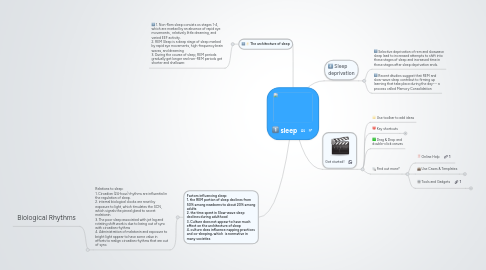sleep
por chris xie


1. Factors influencing sleep: 1. the REM portion of sleep declines from 50% among newborns to about 20% among adults 2. the time spent in Slow-wave sleep declines during adulthood 3. Culture does not appear to have much effect on the architecture of sleep 4. culture does influence napping practices and co-sleeping, which is normative in many societies
1.1. Relations to sleep: 1. Circadian (24-hour) rhythms are influential in the regulation of sleep. 2. internal biological clocks are reset by exposure to light, which timulates the SCN, which signals the pineal gland to secret melatonin 3. The poor sleep associated with jet lag and rotating shift work is due to being out of sync with circadian rhythms 4. Administration of melatonin and exposure to bright light appear to have some value in efforts to realign circadian rhythms that are out of sync.
1.1.1. Biological Rhythms
2. The architecture of sleep
2.1. 1. Non-Rem sleep consists os stages 1-4, which are marked by an absence of rapid eye movements, relatively little dreaming, and varied EEF activity. 2. REM Sleep is a deep stage of sleep marked by rapid eye movements, high-frequency brain waves, and dreaming 3. During the course of sleep, REM periods gradually get longer and non-REM periods get shorter and shallower.
3. Sleep deprivation
3.1. Selective deprivation of rem and slowwave sleep lead to increased attempts to shift into these stages of sleep and increased time in these stages after sleep deprivation ends.
3.2. Recent dtudies suggest that REM and slow-wave sleep contribut to firming up learning that take place during the day--- a process called Memory Consolidation
4. Get started!
4.1. Use toolbar to add ideas
4.2. Key shortcuts
4.2.1. INS to insert (Windows)
4.2.2. TAB to insert (Mac OS)
4.2.3. ENTER to add siblings
4.2.4. DEL to delete
4.2.5. Press F1 to see all key shortcuts
4.3. Drag & Drop and double-click canvas
4.4. Find out more?
4.4.1. Online Help
4.4.2. Use Cases & Templates
4.4.2.1. Personal Todo List
4.4.2.2. Vacation Planning
4.4.2.3. Meeting Minutes
4.4.2.4. Project Plan
4.4.2.5. more...
4.4.3. Tools and Gadgets
4.4.3.1. Offline Mode
4.4.3.2. Geistesblitz Tools
4.4.3.3. Email & SMS Gateways
4.4.3.4. Offline Mode
